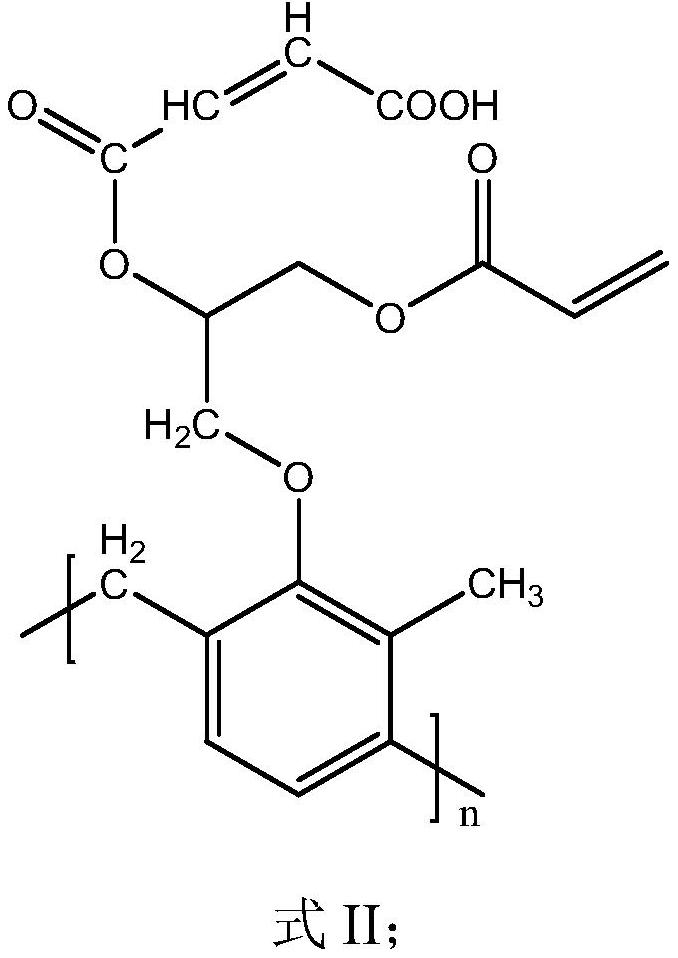A conductive ink with circuit etching performance and its preparation method and application
A conductive ink and etching technology, applied in the direction of ink, application, printed circuit manufacturing, etc., can solve the problems of high equipment cost and energy consumption, low production efficiency, large water consumption, etc., achieve good conductivity, meet market demand, The effect of strong adhesion
- Summary
- Abstract
- Description
- Claims
- Application Information
AI Technical Summary
Problems solved by technology
Method used
Image
Examples
Embodiment 1
[0085] (1) Preparation of conductive ink: Calculated by mass parts, 50 parts of metallic silver powder (flake silver powder with a particle size of 1-10 μm), 15 parts of high acid value matrix resin (high acid value epoxy resin EB), 15 parts of light 1 part of initiator benzoin dimethyl ether (DMPA), 0.5 part of defoamer polyoxyethylene polyoxypropylene pentaerythritol ether, 0.5 part of acrylate leveling agent dissolved in 33 parts of organic solvent acetone, fully mixed by ultrasonic, ultrasonic power is 100W, the ultrasonic time is 30min, and the conductive ink is obtained.
[0086] (2) Coating conductive ink coating: apply the conductive ink obtained in step (1) on the glass sheet by the coating bar coating method, and then let it stand to dry under natural conditions or dry at 80°C in an oven to obtain conductive ink. ink layer.
[0087] (3) Light curing: Cover the conductive ink layer obtained in step (2) with a mask plate with a specific circuit, and then cure it under...
Embodiment 2
[0091] (1) Preparation of conductive ink: Calculated by mass parts, 58 parts of metallic silver powder (flaky silver powder with a particle size of 1-10 μm), 12 parts of high acid value matrix resin (EB), photoinitiator benzophenone (BP) 1.5 parts, defoaming agent polyoxypropylene glyceryl ether 0.5 parts, organosiloxane leveling agent 1 part dissolved in 27 parts of organic solvent acetone, fully mixed by ultrasonic, ultrasonic power 100W, ultrasonic time 30min, obtained conductive ink.
[0092] (2) Coating conductive ink coating: apply the conductive ink obtained in step (1) on the glass sheet by the coating bar coating method, and then let it stand to dry under natural conditions or dry at 80°C in an oven to obtain conductive ink. ink layer.
[0093] (3) Photocuring: Cover the conductive ink layer obtained in step (2) with a mask plate with a specific circuit, and then cure it under the condition of UV irradiation for 700s, the power of the UV lamp is 1000W, and the irradi...
Embodiment 3
[0097] (1) Preparation of conductive ink: Calculated by mass parts, 64 parts of metallic silver powder (flaky silver powder with a particle size of 1-10 μm), 16 parts of high acid value matrix resin (EB), photoinitiator 1-hydroxyl ring 1.5 parts of hexyl phenyl ketone (184), 0.5 parts of antifoaming agent polydimethylsiloxane, 1 part of acrylate leveling agent dissolved in 17 parts of organic solvent acetone, fully mixed by ultrasonic, ultrasonic power 100W, ultrasonic The time is 50min, and the conductive ink is obtained.
[0098] (2) Coating conductive ink coating: apply the conductive ink obtained in step (1) on the glass sheet by the coating rod coating method, and then let it stand to dry under natural conditions or dry at 70°C in an oven to obtain conductive ink. ink layer.
[0099] (3) Light curing: cover the conductive ink layer obtained in step (2) with a mask plate with a specific circuit, and then cure it for 500s under the condition of UV irradiation, the power of...
PUM
| Property | Measurement | Unit |
|---|---|---|
| epoxy value | aaaaa | aaaaa |
| electrical resistivity | aaaaa | aaaaa |
| particle diameter | aaaaa | aaaaa |
Abstract
Description
Claims
Application Information
 Login to View More
Login to View More - R&D Engineer
- R&D Manager
- IP Professional
- Industry Leading Data Capabilities
- Powerful AI technology
- Patent DNA Extraction
Browse by: Latest US Patents, China's latest patents, Technical Efficacy Thesaurus, Application Domain, Technology Topic, Popular Technical Reports.
© 2024 PatSnap. All rights reserved.Legal|Privacy policy|Modern Slavery Act Transparency Statement|Sitemap|About US| Contact US: help@patsnap.com










